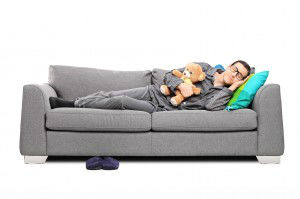
Research has shown that naps can be incredibly beneficial to our health. Luckily, our culture is slowly starting to catch up to this news, as naps have begun to be accepted as part of a normal and healthy lifestyle.
Daytime naps at school or work, for example, are beginning to be seen as more tolerable—and even desirable in some cases—due to the proven health and productivity potential of naps.
For those of us who’ve been told our whole lives that naps are only for the lazy, or for when you don’t get enough sleep the night before, there might be some understandable confusion on the subject. How do you take a good nap? How do you make sure you’re not more groggy afterwards? What’s the best time of the day to take a nap?
Luckily, sleep scientists have been studying napping for more than 40 years, and in that time have come up with some answers that will help all of us discover how to take the perfect nap.
Here’s the most up to date information on nap length, the time of day you should take a nap, and the environment most conducive to napping.
Nap length
Basically, what scientists have found is that if you want to nap longer than 30 minutes, you better be ready to sleep for a full 90 minutes unless you want to feel even groggier than when you fell asleep.
Twenty minutes is actually the perfect nap length, as deep sleep usually starts around the 30-minute mark. The benefits of a 20-minute power nap include improved focus, mood and energy levels.
With a 90-minute nap, on the other hand, you’ll get the benefits of a full cycle of sleep, which include a boost in creativity and memory. Anywhere in between the 20 and 90-minute mark can also be beneficial, as long as you’re prepared to fight through the sleepiness upon waking.
Time of day
Most people get sleepy about six to seven hours after waking up, which puts the ideal nap time at early to mid afternoon. This would make a nap during your lunch hour, or a quick, mid-afternoon power nap, the most optimal.
Just be sure you don’t nap too close to bedtime (after 4pm) or it could disturb your normal sleep schedule.
Environment
Noise, temperature, and smell all make a difference when it comes to taking the perfect nap. A steady background noise, like a white noise track or a fan, are ideal, as abrupt noises can wake you up or prevent you from falling asleep. A cool temperature—about 65-70 degrees Fahrenheit—is best for inducing sleep.
 The way the space smells can also make a difference, as some essential oils like lavender have been shown to help people fall asleep.
The way the space smells can also make a difference, as some essential oils like lavender have been shown to help people fall asleep.
Another suggestion from sleep researchers is to take a ‘caffeine nap,’ where you drink a small amount of caffeine (in the form of coffee or tea) right before you lay down. As caffeine takes about 15-30 minutes to kick in, this will ensure both that you wake up, and that you won’t feel groggy when you do.
Researchers also say that the simple act of laying down and resting for 15-20 minutes with your eyes closed—even if you don’t fall asleep—can be extremely beneficial. So, even if you can’t fall asleep during your ‘nap time,’ as long as you’re resting and relaxing you’re doing something good for yourself!
-The Alternative Daily
Sources:
http://mic.com/articles/106720/this-is-how-you-take-the-perfect-nap-according-to-sleep-scientists
http://www.wsj.com/articles/SB10001424127887323932604579050990895301888
http://lifehacker.com/5950732/the-science-of-the-perfect-nap

